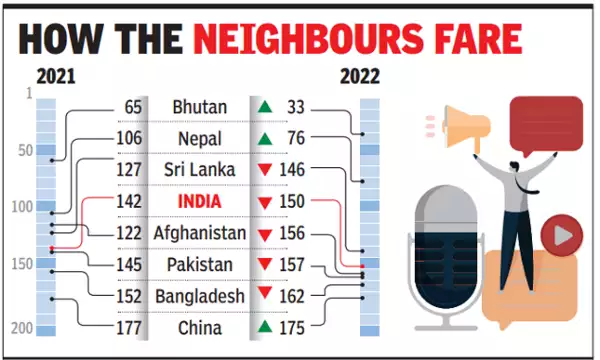Governance
World Press Freedom Index 2022
- 04 May 2022
- 6 min read
For Prelims: World Press Freedom Day, 2022 Press Freedom Index
For Mains: Freedom of Press in India and related issues
Why in News?
On the World Press Freedom Day (WPFD) (3rd May), the 20th edition of the World Press Freedom Index was published by Reporters Without Borders (RSF).
- India ranked 150th among the 180 countries.
What are the Highlights of the World Press Freedom Day?
- About:
- The day was proclaimed by the UN General Assembly in 1993, following the recommendation of UNESCO’s General Conference in 1991.
- The day also marks the 1991 Windhoek Declaration (adopted by UNESCO).
- It aimed towards the ‘development of a free, independent and pluralistic press’.
- Theme for 2022:
- Journalism under digital siege
What is the World Press Freedom Index?
- About:
- It has been published every year since 2002 by Reporters Sans Frontieres (RSF) or Reporters Without Borders.
- Based in Paris, RSF is an independent NGO with consultative status with the United Nations, UNESCO, the Council of Europe and the International Organization of the Francophonie (OIF).
- OIF is a 54 french speaking nations collective.
- Based in Paris, RSF is an independent NGO with consultative status with the United Nations, UNESCO, the Council of Europe and the International Organization of the Francophonie (OIF).
- The Index ranks countries and regions according to the level of freedom available to journalists. However, it is not an indicator on the quality of journalism.
- It has been published every year since 2002 by Reporters Sans Frontieres (RSF) or Reporters Without Borders.
- Scoring Criteria:
- The Index’s rankings are based on a score ranging from 0 to 100 that is assigned to each country or territory, with 100 being the best possible score (the highest possible level of press freedom) and 0 the worst.
- Evaluation Criteria:
- Each country or territory’s score is evaluated using five contextual indicators : political context, legal framework, economic context, sociocultural context and safety.
What are the Highlights of the Performance of the World?
- About:
- The report reveals a two-fold increase in "polarisation" amplified by information chaos, that is, media polarisation fuelling divisions within countries, as well as polarisation between countries at the international level.
- Ranking of Countries:
- Top and Worst Performers:
- Norway (1st) Denmark (2nd), Sweden (3rd) Estonia (4th) and Finland (5th) grabbed the top positions.
- North Korea remained at the bottom of the list of the 180 countries.
- Russia was placed at 155th position.
- India’s Neighbours:
- Nepal has climbed up by 30 points in the global ranking at 76th position.
- The index placed Pakistan at 157th position, Sri Lanka 146th, Bangladesh 162nd and Myanmar at 176th position.
- China was ranked at 175th position.
- Top and Worst Performers:
What about the Performance of India?
- About:
- India has fallen eight places from 142nd to 150th in the 2022 among the 180 countries.
- India’s position has been consistently falling in the index since 2016 when it was ranked 133.
- The reasons behind fall in ranking is the increased “violence against journalists” and a “politically partisan media”.
- Reasons behind the Fall in Ranking of India:
- Pressure from Government:
- According to the index the media in India, among nations reputed to be more democratic, faces pressure from “increasingly authoritarian and/or nationalist governments”.
- Faults in Policy Framework:
- Although the policy framework is protective in theory, it resorts to using defamation, sedition, contempt of court, and endangering national security against journalists critical of the government, branding them as "anti-national."
- India is World’s Most Dangerous Countries for Mediapersons:
- According to the report, India is also one of the world’s most dangerous countries for mediapersons.
- Journalists are exposed to all kinds of physical violence including police violence, ambushes by political activists, and deadly reprisals by criminal groups or corrupt local officials.
- According to the report, India is also one of the world’s most dangerous countries for mediapersons.
- On Kashmir Issue:
- The situation in Kashmir remains “worrisome” and reporters are often harassed by police and paramilitaries.
- Pressure from Government:
What about the Freedom of Press in India?
- The Constitution, the supreme law of the land, guarantees freedom of speech and expression under Article 19, which deals with ‘Protection of certain rights regarding freedom of speech, etc.
- Freedom of press is not expressly protected by the Indian legal system but it is impliedly protected under article 19(1) (a) of the constitution, which states - "All citizens shall have the right to freedom of speech and expression".
- In 1950, the Supreme Court in Romesh Thappar v. State of Madras observed that freedom of the press lay at the foundation of all democratic organisations.
- However, Freedom of press is also not absolute. It faces certain restrictions under Article 19(2), which are as follows-
- Matters related to interests of the sovereignty and integrity of India, the security of the State, friendly relations with foreign States, public order, decency or morality or in relation to contempt of court, defamation or incitement to an offence.







